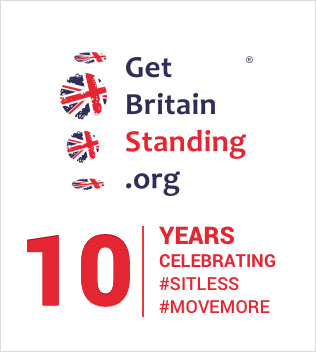Get Britain Standing
In a British study published in 1953, scientists examined two groups of workers: London bus drivers and bus conductors. It concluded that the bus drivers were nearly twice as likely to die of heart disease as the conductors were.
Regrettably 60 years later, the British public remain in the dark of the risks of sitting.
Today "sitting time" is rarely mentioned in any media coverage of heart disease, obesity, diabetes and cancer.
According to the World Health Organisation (WHO) the lack of physical activity is one of the TOP FOUR leading causes of preventable death worldwide, ahead of high cholesterol, alcohol and drug abuse.
British Workplace and SittingSince the COVID pandemic we have lost a lot of “incendetal movement” during the typical working day, especially those who are working from home. In many cases up to 5,000 steps of activity has been lost and replaced by even longer sitting time.
Under British workplace law it is mandatory to have a DSE assessment of your sitting position whilst at a desk… BUT the truth is that there is no correct sitting position for prolonged periods. We are designed to move, and move regularily every hour.
Our bodies are designed to stand, fidget, hover and most importantly move around for every 30 minutes. Standing is the “first gear” of physical activity and from this position we are much more likely to further move, fidget or walk. Standing engages key posterior muscles which keep our organs and metabolism engaged. Importantly standing reduces the repetitive stress and muscle degeneration that is caused by sitting.
Dr Stuart Biddle, Professor of Active Living & Public Health, Victoria University, Australia.
"Even if you exercise for at least 30 minutes most days, you are still storing up health problems from being sedentary too much. The message is clear - move more and sit less."
In January 2015 Public Health England and Gavin Bradley (founders of the Get Britain Standing campaign) jointly commissioned an Expert Statement on the status and impact of prolonged sitting in the office (Download).
Health Risks
When sitting more than 4 hours a day. This may raise your eyebrows.Solutions
Sit-Stand solutions for every budget and simple tips for "Active Working".Employers
Higher productivity and better engagement. Learn more ...Individuals
You will burn lots more calories and become healthier. Find out more ...
Summit 2022
Invitation to leaders & decision makers from FM, HR, Health & Wellness sectors.
Top 10 Risks
Key health risks you face when sitting more than 4 hours each day.
Active Working
Simple solutions to encourage standing and movement at work.
 FREE SHIPPING|
FREE SHIPPING|
 NL
NL EU
EU GER
GER FR
FR BEL
BEL UK
UK





















